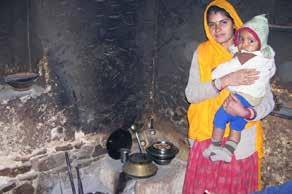
Two issues that significantly impact the health of the people in the rural areas are the use of solid fuel for cooking and the use of kerosene for lighting. In addition to the adverse health impacts because of the large quantity of emissions (refer figures), the practice of using solid fuel for cooking also involves a huge amount of drudgery in order to collect the fuel wood. This could be as much as walking about 3 - 5 km/day and mostly involves women. These issues have primarily been addressed in two ways: (1) the traditional top-down, non-participatory approach where the rural residents receive a technology developed somewhere else and by someone else, and (2) the more recent bottom-up, participatory approach where the residents themselves are involved in both identifying the problem and developing a solution for it with
the assistance of experts. Regarding the use of cookstoves, it has been documented that many improved-cookstoves programs faced failures due to the lack of adaptation of the improved cookstove by most of the households or due to just partial usage of the cookstoves because of various constraints related to the existing
cooking practices. Against this background, it is imperative to assess an improved-cookstove program that adopts a bottom-up approach in order to take into account the users’ priority of needs, the various aspects and constraints of the existing cooking practices, and affordability for designing and disseminating the improved-cookstove technologies. This study aims at quantifying and analysing the difference between the social acceptance levels of the various technological solutions disbursed
through the participatory and the non-participatory approaches. This shall be done through detailed field surveys and impact assessment studies. These surveys are themselves participatory in nature. The study intends to reveal a number of learnings and guidelines that may be used by the various improved-cookstove dissemination programs in order for them to significantly increase the probability of their success.
Prof. Anish Modi
